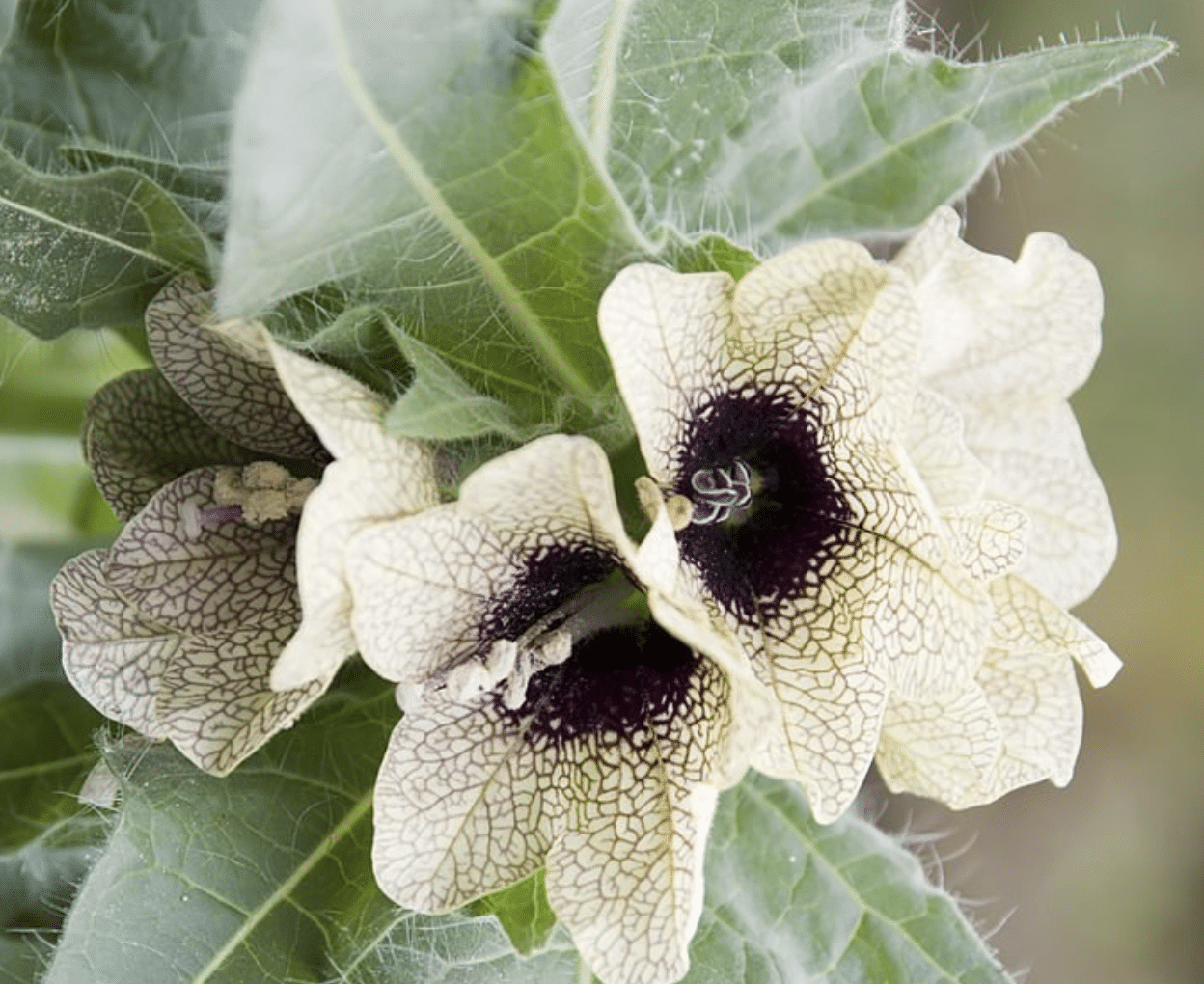According to the World Health Organization (WHO), nearly 80% of the world’s population relies on herbal medicine for primary healthcare. Among the various plants used, the Hyoscyamus species stand out for their rich phytochemical composition. By understanding these aspects, we can better appreciate the therapeutic potential and safety considerations of using these plants in traditional and modern medicine. The findings highlight the importance of phytochemical research in validating and optimizing the use of herbal medicines for healthcare around the world. [1]
The species of pharmaceutical interest are:
- Hyoscyamus albus L., which with its plant extracts was a medicine traditionally used as an anti-asthmatic and antispasmodic. It is now important for applications in anti-diabetic treatment. [2]
- Hyoscyamus niger L. has a long medicinal history, used as a sedative and painkiller. It treated mental disorders, epilepsy, insomnia, neuralgia, asthma, colic, toothache, and various pains. Seed oil was applied for neuralgic, dental, and rheumatic pain. It also treated bronchitis, conjunctivitis, urinary issues, and more. Since 2016, studies have been conducted in favor of the use of crude extracts for the treatment of pathologies affecting the cardiovascular system. [2]
- Hyoscyamus reticulatus L., was used in asthma, gastric ulcers, for motion sickness and in Parkinson’s disease. It was also used as mydriatic, spasmolytic, analgesic, sedative and as antidote for intoxications of many poisons. Researchers demonstrated that some extract could show antibacterial activity, but not every extraction method performed this efficacy against the most investigated human pathogens. [2]
Extraction Methods
Alkaloids
The sample preparation involves the collection and drying of the plant material (leaves, seeds, roots) which will then be ground into a very fine powder. The crude extract is obtained by dissolving the powder in an acidic aqueous solution (e.g., dilute HCl) or using Soxhlet extraction, then filtering to remove plant debris.
To proceed with the isolation of alkaloids it is necessary to adjust the pH to basic (for example with ammonia). By performing a liquid-liquid extraction with an organic (e.g., chloroform) and drying, the crude extract is obtained. It is possible to recrystallize to obtain pure alkaloids.
Characterization is achieved by confirming the presence of the compounds of interest via TLC and quantifying them via HPLC or MS. Verification can be performed with structural analysis using NMR or IR.
Phenols
Sample preparation always includes collecting and drying the plant material (leaves, seeds, roots) and then grinding it into a fine powder. Extraction is performed by soaking powder in an organic solvent (e.g., methanol or ) using maceration or Soxhlet extraction, then filtering.
To remove non-phenolic compounds, the residue is dissolved in water and separated by partitioning with an organic solvent (for example ethyl acetate). Column chromatography can be used for further purification.
Characterization is achieved by confirming the presence of the compounds of interest via TLC and quantifying them via HPLC or Spectrophotometry. Verification can be performed with structural analysis using NMR or IR.
Phytochemical Composition of The Hyoscyamus Species
Herbal medicine primarily used the leaves of the plant, but also made use of the roots and seeds of the plant.
Preliminary phytochemical analysis showed that Hyoscyamus albus L. contains various chemical constituents, including alkaloids, flavonoids, tannins, terpenes, saponins, carbohydrates, cardiac glycosides, and anthraquinones. Total polyphenol content is 48.54 ± 7.82 mg GAE/g dry weight, total flavonoid content is 27.39 ± 0.87 mg rutin/g dry weight, and total alkaloid content is 1%. The majority of the isolated alkaloids were hyoscyamine (atropine) with percentages of 63.8%, 77.8%, 70.2%, 66.3%, and 80.4% found in the roots, stems, leaves, flowers, and seeds, respectively.
Scopolamine was the second most common alkaloid, with percentages of 4.2%, 9.1%, 16.6%, and 6.4% found in the same locations. The hairy roots of the plant H. albus L. were used to extract sesquiterpene-type phytoalexins, in particular these molecules are antimicrobial and often antioxidative substances synthesized by plants in response to pathogen attack or stress. They help protect plants from infections and enhance their resistance to diseases. [1]
Hyoscyamus niger L. contains 0.06–0.13% tropane alkaloids (hyoscyamine, apohyoscine, scopolamine, skimmianine, apoatropine, α-belladonnine). Root cultures show hyoscyamine at 7.8 ± 1.6 mg/g and scopolamine at 29.97 ± 0.60 mg/g. Various steroidal glycosides and saponins have been identified in seeds, along with lignanamides and non-alkaloidal compounds like hyoscyamide and β-sitosterol.
Hyoscyamus niger L. yielded a number of flavonoids when it was analyzed, including rutin and spiraeoside. The chlorogenic acid, quercetin-3O-glucosiderhamnoside-rhamnoside (QGRR), and rutin in H. niger L. leaves were found at concentrations between 0.4 and 0.0, and 9.2 and 0.5 mg/g, respectively. In the epicalyxes, they measured 3.5±0.4 mg/g dry weight. [1]
Hyoscyamus reticulatus L. contains high levels of the tropane alkaloids hyoscyamine (0.031-0.056% dry weight) and scopolamine (0.011-0.015% dry weight):
- A titration of Iranian samples yielded a hyoscyamine concentration of 0.031% and a scopolamine concentration of 0.025%. [3]
- Turkish leaves had 0.011-0.027% total alkaloids, with leaves containing the highest and stems the lowest. [4]
Ten tropane alkaloids were identified in vitro, including hyoscyamine and scopolamine. Total phenolics were 15.86 mg GAE/g in hexane extracts and 24.25 mg GAE/g in water extracts. The leaves had chlorogenic acid (3.4 mg/g), quercetin-3O-glucoside-rhamnoside (19.9 mg/g), and rutin (8.9 mg/g). [1]
Alkaloid synthesis can be modulated by external factors such as light, heat, altitude, soil structure, and nitrogen content in soil or herbicide applications. It has been reported that there is a negative correlation between soil pH and tropane alkaloids, meaning that the lower the pH, the lower the concentrations of alkaloids produced. In fact, pH increases with nutritional elements very often used in chemical fertilization such as Ca, N, K and P. [5]
Therapeutic Application in Recent Studies
Hyoscyamus species exhibit diverse pharmacological effects.
Anti-Diabetic Effects
Researchers in 2023 analyzed Hyoscyamus albus L. ethanolic leaves extract and identified 18 distinct phenolic compounds. Among these, p-coumaric acid (6656.8 ± 3.4 µg/g), gallic acid (6516 ± 1.7 µg/g), luteolin (6251.9 ± 1.3 µg/g), apigenin (6209.9 ± 1.1 µg/g), and rutin (5213.9 ± 1.3 µg/g) were identified as the most abundant polyphenolic molecules. In the in vitro antidiabetic experiment, the ability of the plant extract to inhibit α-glucosidase and α-amylase activities was examined.
The results indicated that the extract exhibited a higher inhibitory effect on α-amylase compared to α-glucosidase. Additionally, rutin, kaempferol, and quercetin, known for their anti-inflammatory properties, were found in relatively high concentrations in H. albus, suggesting its potential for mitigating and treating chronic human conditions. [6]
Docking simulations revealed that luteolin, fisetin, and rutin exhibited the most promising inhibitory activity against both enzymes, as indicated by their high contrasting inhibition scores. Phenols have been shown to reduce blood glucose levels through various mechanisms, including the downregulation of carbohydrate digestion and intestinal glucose uptake, activation of pancreatic insulin production, stimulation of hepatic glucose release, and facilitation of glucose assimilation in insulin-sensitive tissues. [6]
To further investigate the in vivo antidiabetic effects, an experiment was conducted using induced diabetic mice. The results demonstrated that the plant extract effectively reduced the levels of cholesterol and triglycerides. These findings suggest that H. albus L. may have therapeutic potential for managing hyperlipidemia, a common complication associated with diabetes. This highlights its potential as a natural remedy for diabetes and related conditions. [6]
Cardiovascular Effects
Scholars in 2016 concluded that Hyoscyamus niger L. crude extract caused a dose-dependent fall in the arterial blood pressure of rats under anesthesia. In guinea-pig atria, exhibited a cardiac depressant effect on the rate and force of spontaneous atrial contractions. The cardioprotective activity of the crude powder of the H. niger L. was studied in rats. Many biochemical parameters were evaluated to assess the cardioprotective effect of crude powder extracts in isoproterenol induced myocardial injury. When administered orally for 30 days, the crude powder of H. niger L. aqueous suspension was effective in protecting the heart of rats from isoproterenol-induced lipid oxidation and activation of antioxidant enzymes. [7]
Antimicrobial Activity
Researchers in 2020 determined the antimicrobial activity of the ethyl alcohol seed extract obtained from H. reticulatus L. against some Gram-positive and Gram-negative bacteria and to perform elemental chemical analysis of the seed contents of H. reticulatus by the XRF method. X-ray fluorescence is a non-destructive analytical technique used to determine the elemental composition of materials.
The seeds were ground and prepared for analysis. Standard strains of Salmonella enteritidis, Escherichia coli, Pseudomonas aeruginosa, Staphylococcus aureus, and Yersinia enterocolitica were used to determine the antimicrobial effects of the ethyl alcohol seed extract. The results showed that the ethyl alcohol extract of H. reticulatus seeds used in this study had no antibacterial effects. [8]
However, other authors reported that the alkaloids extracted from the flowers, stems, and roots of H. reticulatus L. and H. niger L. had a strong antimicrobial effect. [8] And even other researchers stated in their study that the methanol extract of the aboveground parts of H. reticulatus had antibacterial activity. [9]
Therefore, it can be said in the first reported study that the antibacterial active substances in H. reticulatus L. seed have not been revealed due to the extraction method or solvent. Appropriate extraction methods can be investigated by determining the active ingredients responsible for the activity in the extract. [5]
References:
- Bonde, Atul Ramesh, and Rukhsana Mahiboob Pinjari. “Therapeutic Importance of Hyoscyamus Species-A Review.” (2023)
- Al-Snafi, Ali Esmail. “Therapeutic importance of Hyoscyamus species grown in Iraq (Hyoscyamus albus, Hyoscyamus niger and Hyoscyamus reticulates)-A Review.” IOSR Journal of Pharmacy 8.6 (2018)
- Souri E, Amin G, Dehmobed-Sharifabadi A, Nazifi A and Farsam H. Antioxidative activity of sixty plants from Iran. Iranian Journal of Pharmaceutical Research. (2004)
- Kartal M, Kurucu S, Altun L, Ceyhan T, Sayar E, Cevheroglu S and Yetkin Y. Quantitative analysis of lhyoscyamine in Hyoscyamus reticulatus L by GC-MS. Turk J Chem. (2003)
- Akbaş, Perihan, et al. “Determination of the content of Hyoscyamus reticulatus seeds by XRF method and antibacterial characteristics of ethyl alcohol extract.” Eskişehir Technical University Journal of Science and Technology A-Applied Sciences and Engineering 21.1 (2020)
- Lekmine, Sabrina, et al. “LC/MS-MS analysis of phenolic compounds in Hyoscyamus albus L. extract: In vitro antidiabetic activity, in silico molecular docking, and in vivo investigation against STZ-induced diabetic mice.” Pharmaceuticals 16.7 (2023)
- Vallabi DE and Elango V. Preliminary studies on cardio protective effect of Hyoscyamus niger Linn in male albino rats. Journal of Chemical and Pharmaceutical Research (2016).
- Chalabian F, Majd A, Mehrabian Saeid, Falahian F. A Study Of Growth Inhibitory Effect of Alkaloids of Two Species of Genus Hyoscyamus on Some Kinds Of Microbes of Skin (2002)
- Bazzaz BS, & Haririzadeh G. Screening of Iranian plants for antimicrobial activity, Pharmaceutical Biology (2003)

